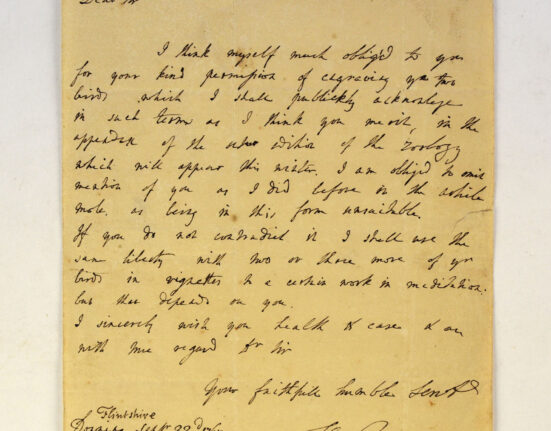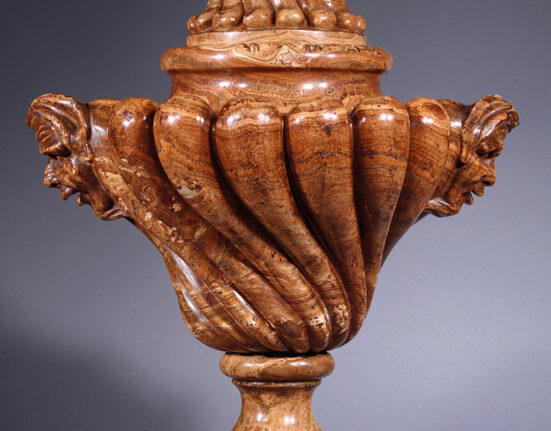OTTERLO, the Netherlands — “This work is installed when the word ‘Time’ is spoken,” says a single white sheet of paper framed behind glass. That is the full extent of the conceptual artwork “Time Spoken” (1982) by Ian Wilson.
In the corner of a gallery at the Kröller-Müller Museum in De Hoge Veluwe National Park, we quietly whisper, “Time.” And we have “installed” a work of art. And then we laugh.
Such is the comical and sometimes philosophical nature of many of the works on display in this exhibition, “Not in So Many Words,” on view until May 10. About a two-hour drive from Maastricht, the museum makes a scenic and cultural side trip for visitors to the European Fine Art Fair, or TEFAF, with an exquisite permanent collection that features one of the world’s largest troves of Vincent van Gogh paintings and a sprawling outdoor sculpture garden.
“Not in So Many Words” focuses on art that employs text — letters, words, sentences, fragments and the spoken word — and undermines the notion that art is a primarily visual medium.
Many of the pieces are Conceptual, using texts to make us muse on the nature of art itself. The Belgian poet and artist Marcel Broodthaers, for example, writes his signature, M.B., repeatedly on a large piece of tracing paper, daring us to question its authenticity as a work of art. (After all, doesn’t a signature on a work usually convey authenticity?)
In a companion piece, the Italian artist Piero Manzoni in 1969 printed a “declaration of authenticity” on official letterhead from the Musée d’Art Moderne in Brussels, certifying that Mr. Broodthaers was an artist. The title: “Piero Manzoni declares Broodthaers to be an authentic work of art.”
“There’s a lot of humor in these works,” Renske Cohen Tervaert, a curator for the Kröller-Müller, said in a telephone interview. These artists “were very much looking for ways of placing art in a very different sphere. There’s a participation of the audience as well. It’s not just looking.”
Ms. Tervaert said she organized the exhibition after noticing that many of the artworks in the museum’s permanent collection had some connection to poetry, philosophy or just language more generally. Most of the works in the show are from the museum’s own trove.
“I started to look at the question, ‘When did artists start using words or typography or language in art?’” she said. “These were forms that weren’t linked to each other in the past, but you see that in the 20th century they do become linked.”
Until about 1911, she explained, fine artists used text in paintings only for practical purposes, to convey the name of a person in the portrait, for example, or occasionally to show the title of the work. The Cubists were the first to start to use text for other reasons, she added. One of the earliest examples of this in the show is Juan Gris’s 1916 painting “Cartes à jouer et siphon” (Playing cards and siphon), in which the words “Le Journal” (the newspaper) appear in a Cubist still life of a card table.
Later, Cubists and Dada artists used newspaper clippings or text torn out of other printed matter to create collages with what at the time would have been considered jarring juxtapositions. Text continued to be present in art through the Surrealists, but became commonplace in the middle of the 20th century, with the rise of Conceptualism.
A 1966 short film, “Word Movie,” by the Fluxus artist Paul Sharits, presents the viewer with a fast-changing series of random words, such as “duck,” “hormone” and “chrome,” while a male and a female voice alternate speaking one word each, composing a language of gibberish. If each voice were heard separately, the museum’s description informs us, each would make sense. But spliced together, they lose coherent meaning.
As with this work, others highlight the fact that while we think of language as a way of conveying meaning, it can also be a tool for disorientation.
“He’s playing with our senses,” Ms. Tervaert said of Mr. Sharits. “As a human being, we want to understand things. When we see text we want to read it, but in a playful and humorous way, he wants to shake up our desire to comprehend things.”
Artists from the 1960s and ’70s used text so frequently that it is now considered a “normalized” part of visual art, said Ms. Tervaert, such that when we see one of Jenny Holzer’s wall text one-liners such “If You’re Considered Useless No One Will Feed You Anymore” (1983), we no longer question whether it qualifies as art.
Ms. Holzer has explained in the past that she “used language because I wanted to offer content that people — not necessarily art people — could understand,” and she has printed her truisms, as she calls them, on posters, T-shirts and even condom packaging. For at least some contemporary artists like her, text is not a radical element that moves us away from our traditional notions of art but rather helps art become more accessible.
Three of the works in the exhibition are newly commissioned, bringing us up to present-day uses of text in art.
A long black pen is suspended by an invisible thread over a table. It dances over a sheet of white paper, making tiny black marks. Underneath, the table vibrates like a drum, responding to what is coming out of a speaker mounted to its side.
This work, “Vocode,” is creating a visual record of 86 nearly extinct languages that are listed in UNESCO’s atlas of the world’s endangered tongues. Even, Chontal, Trumai, Waima’a and Savosavo are a few of the languages the artists chose.
Created by Fillip Studios, or the art duo Roos Meerman and Tom Kortbeek, the artwork is the most recent piece in the exhibition and perhaps the most compelling. In it, we find ourselves boomeranged back to the beginning of the narrative: Text is once again converted into a visual art.







